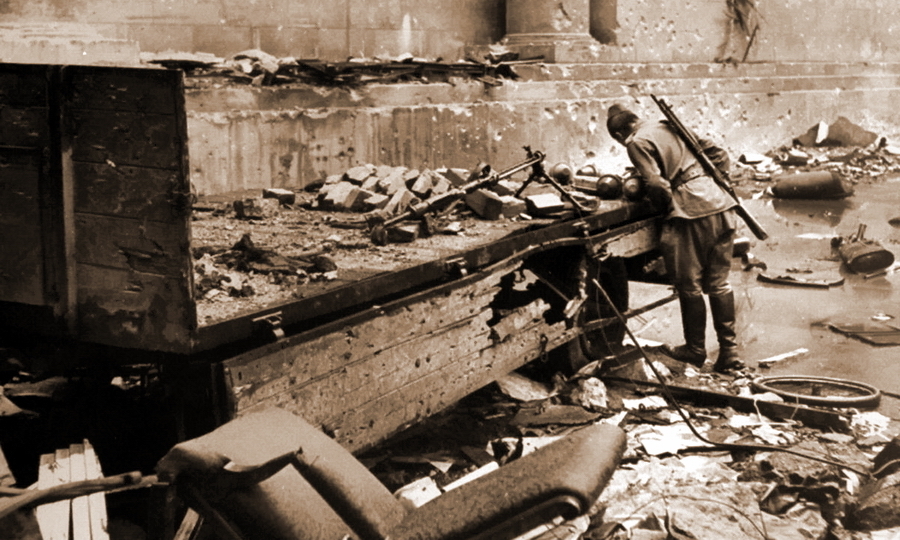When moviemakers show the end of World War II, the German Faustpatrones look very powerful. One shot – one tank, at unbelievable distance, and that’s the way. Of course while watching a movie people do not want to ponder on why such a perfect weapon did not prevent the Soviet T-34 and American “Sherman” appearing on the German city streets, but still… How effective the German anti-tank grenade launchers were?
Working on the bigger picture
Conventional wisdom holds that the first Faustpatrone version was born in 1942, when Wehrmacht panzer divisions were still boldly raising dust on the roads, forming blue arrows towards Stalingrad and Caucasus on the map. Reports about the amount of Soviet tanks destroyed at the Eastern Front have encouraged joy among the Wehrmacht command from seeing the triumph of German warfare, however serious thoughts remained. Even after losing most of its territory the Soviet Union produced countless tank hordes, at the same time across Atlantic the United States that recently joined the war started unfolding their military production effort. At the beginning American-produced machinery was not so good, but already great in numbers: in the same 1942 the United States produced more that 26 000 of various tanks – slightly more than the Soviet Union.

Of course, artillery, tanks, sometimes air force and mines were considered as primary anti-tank tools. However in reality, early years of war have proved that infantry needs effective anti-tank remedy as well – preferably mass produced, easy to use and as cheap as possible. The initial requirements to the new weapon were brief: range 30 meters and more effective than Gew.Pz.Gr. 61 rifle grenade.
Dr. Heinrich Langweiler from the German company Hugo Schneider AG (HASAG) was one of those who answered the call of the Wehrmacht Weapons Agency (Heereswaffenamt). Interestingly enough, it was some kind of a side job for him: Langweiler was ballistics expert and worked on the active-reactive ammo project since 1939. He had a vague understanding of how to make anti-tank weapon, it is unsurprising that first Faustpatrones were far from ideal.
The short tube of grenade launcher was easy to carry, however a shooter had to stay as far away from it as possible, which poorly affected the accuracy. Impact fuse refused to detonate on contact with sloped armour, furthermore the pointy shape of early grenades facilitated bouncing. Finally, spin-stabilisation, apparently, greatly lowered penetrating capability of a cumulative jet. In fact, in Langweiler’s first samples, only the idea of a low-grade steel tube, that was capable of throwing 30 or even 60 meters away anything posing a threat to a tank, merited attention (honestly saying, without any chance of hitting a target).
Despite all of this the work continued. Langweiler prepared to the next stage more thoroughly by constructing two samples. “Small” (klein) sample was a continued development of the first version but with improved grenade. New, more streamlined shape ensured maximum shooting range distance of 70 meters – however the sight had only one notch for 30 meters. The second “larger” version was much more interesting. Langweiler was inspired by the Hafthohlladung, also known as the “Panzerknacker” – magnetic charge anti-tank handgrenade, and the new grenade launcher version weighing a bit more than 5 kg had an impressive penetration, and it could overmatch 200mm of armor.

Both versions were ordered for military testing in lots of 3000 pieces. Early reports from the frontline revealed that concept “more – isn’t less” worked: in most cases the “big” version was preferable. Moreover, infantry asked to increase firing distance, because approaching within 30 meters from roaring T-34 was unsafe. The request was fulfilled by increasing expelling charge first to 140 grams, then to two 95 gram pieces. Although, Faustpatrone (or Panzerfäust as they were called eventually) production fully unfolded in the second half of 1943, despite its simplicity.
“Brigade has suffered losses – two tanks and one SPG”
In its turn the USSR reacted fairly promptly to the German novelty. While first intelligence reports usually contained recitation of data received from captives along with pictures based on these insights, then later frontline units received quite detailed instructions with photos, extensive specifications and counter-exploitation techniques. For example, in January 25, 1944 the Tank and Mechanized Troops headquarters instruction of the 1st Belorussian Front stated that shielding in the manner of German Pz.Kpfw.IV tanks was a reliable method of defense from high-explosive mines and shells. Until it is not implemented, tanks should not turn their sides to trenches with grenadiers and concentrate their fire on them.

After a while Germans got a lot more Faustpatrones – in total they have managed to manufacture more than 8 million pieces. However, Soviet command was not intimidated by this fact and has not demanded “to do anything immediately”. Instead, as a result of the offensive summer campaign of 1944, reports about widespread use of Faustpatrones and Ofenrohres (reusable anti-tank rocket launcher) were followed by reports of this kind: “moreover, enemy abandoned large amount of them on the battlefield”.
Overall, the Germans themselves agreed to a not really good evaluation of Faustpatrone role, for example in February 1944 they claimed destruction of 1219 Soviet tanks in total, wherein Faustpatrones were involved only in 35 cases out of 1219. Even after the frontline moved to the Germany territory with its dense urban regions there was no sudden spike of losses:
“Management division of the 2nd Ukranian Front Tank and Mechanized Troops headquarters have reported that in February 1945 out of total 160 tanks and SPG damaged in combat only two cases involved Faustpatrones, which is 0,5-0,6% of the total number of losses. Damage dealt to the tanks characterized as follows: first T-34 tracks were damaged from 50 meters, second T-34 took a hit from 50 metre distance that cracked his side sloped armor plate”.

As we can see from the report, even if a Faustpatrone grenade hit T-34, a tank was rarely blown up to pieces. There is another similar document:
“Operations division of the 1st Red Banner Istenburg Tank Corps headquarters to №0802 from 31.03.1945. Pursuant to the order of the Corps Commander about [evaluation] effectiveness of German anti-tank rifles and Faustpatrone launchers, and our tanks and SPG’s lost in battle, informing that for the whole period of the campaign in East Prussia (January-February of 1945) the Brigade sustained losses from Faustpatrones – two tanks and one SPG in Trausitten region”. The Brigade has not suffered any casualties from Panzerschreck and Ofenrohr anti-tank weapons fire. The Brigade has no information about enemy’s unit organization and his anti-tank weapon stock. Brigade Chief of Staff of the 89th Order of Kutuzov Tilsit Tank Brigade lieutenant colonel Vasiliy Glushkov, April 4, 1945”.
In addition, the 89th Tank Brigade instead of staying in the back in January-February of 1945, actively participated in battle near Königsberg. In February alone it lost 50 T-34 set on fire and 38 T-34 destroyed. During the battles Brigade was replenished twice, receiving 44 tanks. Of course, jumping to conclusions regarding Faustpatrone effectiveness based on reports of a single brigade is premature. Fortunately, a lot of documents about Soviet tank forces action during second half of the war were preserved.

For example, at the beginning of the same victorious 1945 severe tank losses on March 22-24 during bridgehead expansion on the west Oder bank by the 8th Guards Army commanded by Colonel General Vasily Chuikov were investigated upon the order of Marshal Georgy Zhukov. The report about investigation results says a lot about mistakes of the Military Intelligence that failed to notice enemy’s preparations for repulsing Soviet offensive, flawed operation plan, incorrect troop reports, lack of cooperation with infantry and many more. Faustpatrones were mentioned only in resulting chart: out of 122 lost tanks and SPG’s 98 were lost because of artillery and tanks, 15 vehicles were lost because of landmines; only 7 cases are related to Faustpatrones, and two more tanks were incapacitated by aircraft bombardments. In March 1945 German infantry armed with Faustpatrones couldn’t do much against soviet troops even when encounter was unfortunate to the latter.
Next example. Losses of the 9th Tank Corps, that participated in Vistula-Oder operation and fought in East Pomerania afterwards, were serious. In 1945 from January 14 to March 14 135 tanks and SPG’s were considered as irrecoverable losses, 79 vehicles were sent for capital repairs, and 190 for refurbishment. Faustpatrones were responsible for only 9 lost T-34 out of more than 400. It is exactly one more vehicle lost compared to losses from aircraft bombardments, but significantly less compared to what the Tank Corps have lost when forcing water barriers – one IS-2 and 37 T-34 have sunk.

At last, the Battle for Berlin became the final act of Faustpatrone. Apparently, there can be no doubt about their role, however… For example, it is believed that the 2nd Tank Army, commanded by Colonel General Semyon Bogdanov, took the hardest hit from the German grenade launchers. However, based on the Colonel General’s report about actions taken by the unit during Berlin Operation, Faustpatrones caused 106 losses out of total 576 armored vehicles lost, which is around 18,4%. The reason of such good result is explained in the same report – Bogdanov wrote a lot and in great detail about the lack of infantry:
“Infantry troops working together with tanks were clearing only lower floors of buildings, leaving untouched the remaining, in this way providing opportunity to snipers and Panzerfaust armed troops to fire at tanks”
Deputy Commander of the Tank and Mechanized Troops of the Red Army Marshal Pavel Rotmistrov has added his important notes as well:
“Assault groups formed in tank army units during preparation for Berlin Operation were basically disbanded even before the assault started, as a consequence of intense fights on the outskirts of city. Had to restore the groups when the fight has already started. These circumstances as well as extreme shortage of infantry troops in tank armies significantly lowered effectiveness of assault group actions. Assault groups created within field armies after being reinforced with tanks from assigned tank corps and tanks from infantry support groups revealed great sustainability and survivability due to sufficient number of infantry troops. The same goes for assault groups created within mechanized corps”.
Even in a fairly advantageous conditions – inside a large city, in fight with tanks that had insufficient infantry support – Faustpatrone didn’t even begin to prove itself as a wonder-weapon. Bearing in mind specific demands of 2-4 metres of free space behind grenadier it’s not obvious that simple grenades and bottle bombs could be much worse for throwing them from upper floors on tanks passing by underneath. Anyway, it was too late to wait for something supernatural from “wonder-weapon”, when Soviet tanks were already rumbling on paved roads of Berlin.







